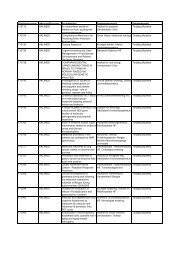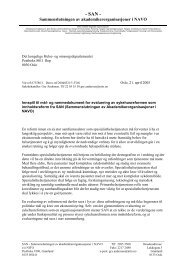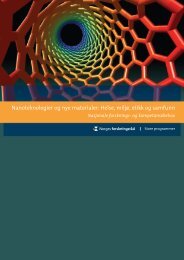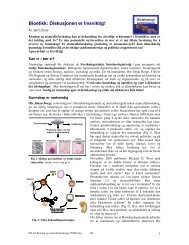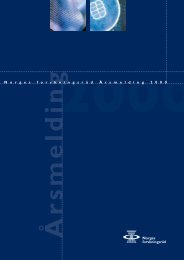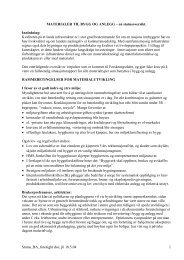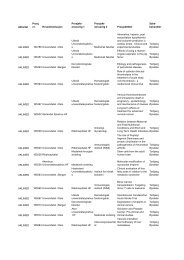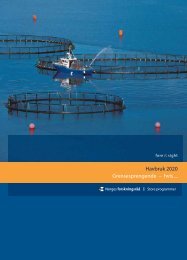A Revolution in R&D
A Revolution in R&D
A Revolution in R&D
Create successful ePaper yourself
Turn your PDF publications into a flip-book with our unique Google optimized e-Paper software.
tified through the use of animals and tissue cultures,<br />
and so their relevance to human disease is<br />
largely speculative.) In other words, there is no possibility<br />
of failure <strong>in</strong> target validation, because identified<br />
targets are ipso facto validated. (This is, of<br />
course, no guarantee of their drugability—their<br />
responsiveness to small-molecule <strong>in</strong>tervention.)<br />
It would not be possible to overstate the value of <strong>in</strong><br />
vivo human validation. Most of what passes for<br />
target validation today is largely conjectural <strong>in</strong><br />
relation to the disease <strong>in</strong> question.<br />
—Diabetes researcher,<br />
Harvard Medical School<br />
Second, the frequency of the causal polymorphisms<br />
is known at the outset. If a study identifies multiple<br />
genes associated with a particular disease, it will<br />
also reveal their relative culpability. Consider the<br />
example of Alzheimer’s disease, a heritable but<br />
genetically complex disorder. On the one hand,<br />
there are variants <strong>in</strong> three genes—PS1, PS2, and<br />
APP—that are very rare but very potent: if a person<br />
has any of them, he or she is almost certa<strong>in</strong> to<br />
develop Alzheimer’s. On the other hand, there is<br />
the ApoE4 polymorphism of the ApoE gene, which<br />
has a more modest effect on disease susceptibility<br />
but is much more common <strong>in</strong> the population at<br />
large, and among patients with Alzheimer’s.<br />
Information of this k<strong>in</strong>d can be useful for predict<strong>in</strong>g<br />
a drug’s potential marketability: although it<br />
might be equally feasible to develop a drug that<br />
<strong>in</strong>fluences the rarer variants, a drug target<strong>in</strong>g<br />
ApoE4 might expect broader effectiveness, and<br />
thus a larger market, and so might take precedence<br />
<strong>in</strong> further research. (The rarer variants may still be<br />
worth pursu<strong>in</strong>g, us<strong>in</strong>g pathway analysis.)<br />
F<strong>in</strong>ally, the nature of the relevant polymorphisms is<br />
known—different disease-<strong>in</strong>duc<strong>in</strong>g mechanisms<br />
among variant forms, for <strong>in</strong>stance. Such <strong>in</strong>formation<br />
may help to streaml<strong>in</strong>e cl<strong>in</strong>ical trials if used by<br />
efficacy-based pharmacogenetics to identify “nonresponders”—patients<br />
who lack the crucial DNA<br />
alteration, and hence are unlikely to experience the<br />
<strong>in</strong>tended effect of a candidate drug—and exclude<br />
them from the trials. (In model<strong>in</strong>g the potential of<br />
disease genetics, we have <strong>in</strong>cluded this effect of<br />
efficacy-based pharmacogenetics. See the section<br />
on pharmacogenetics below for further details.)<br />
Depend<strong>in</strong>g on the approach taken, cost sav<strong>in</strong>gs per<br />
drug could be as great as $420 million, with the<br />
potential time sav<strong>in</strong>gs rang<strong>in</strong>g from 0.7 to about 1.6<br />
years (produc<strong>in</strong>g an added $290 million of value<br />
per drug). (See Exhibit 6.) Of the cost sav<strong>in</strong>gs, the<br />
vast majority would be yielded by the improvements<br />
<strong>in</strong> success rates: $390 million, consist<strong>in</strong>g of $110<br />
million <strong>in</strong> validation and $280 million <strong>in</strong> the cl<strong>in</strong>ic.<br />
EXHIBIT 6<br />
DISEASE GENETICS OFFERS GREAT SAVINGS POTENTIAL<br />
Cost to drug<br />
Pre-genomics<br />
Candidate<br />
gene study<br />
Genome-wide scan<br />
Genome-wide scan<br />
plus pathway analysis<br />
Time to drug<br />
Pre-genomics<br />
Candidate<br />
gene study<br />
Genome-wide scan<br />
Genome-wide scan<br />
plus pathway analysis<br />
ID Biology<br />
Target ID Target Validation<br />
0<br />
0<br />
200<br />
5<br />
Chemistry<br />
400<br />
Screen<strong>in</strong>g Optimization<br />
10<br />
460<br />
485<br />
455<br />
600<br />
800<br />
13.1<br />
15<br />
14<br />
14.7<br />
Development<br />
16.5<br />
Precl<strong>in</strong>ical Cl<strong>in</strong>ical<br />
SOURCES: Industry <strong>in</strong>terviews; scientific literature; public f<strong>in</strong>ancial data;<br />
BCG analysis.<br />
880<br />
1,000<br />
$M<br />
20<br />
Years<br />
29



